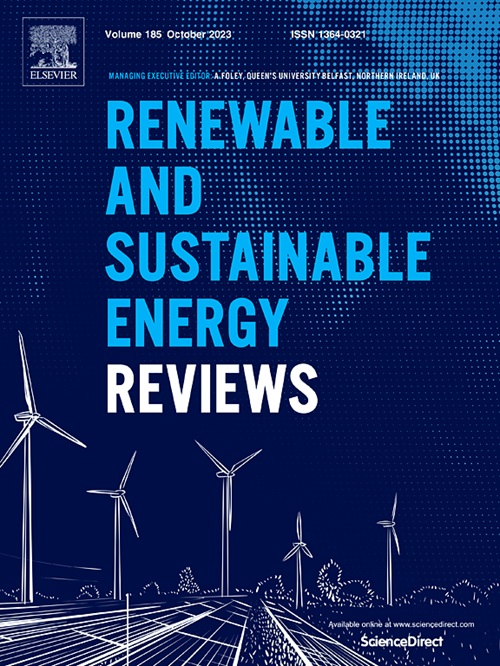氢在美国工业脱碳中的作用:综述
IF 16.3
1区 工程技术
Q1 ENERGY & FUELS
引用次数: 0
摘要
人们对氢越来越感兴趣,因为它可以使难以减排的工业脱碳。然而,确定目标行业、机会规模以及如何满足到2050年的氢需求是复杂且高度不确定的。本次审查中确定的最重要的脱碳机会是在炼油和化工行业,如果用清洁氢取代排放密集型灰氢,到2050年,年排放量可能会从2021年的水平减少24%。新的(清洁)氢应用包括在炼钢中替代碳基还原剂(到2050年炼钢减排不超过18%),以及在水泥、铝和玻璃制造中替代高温热源,到2050年行业年度减排分别高达23%、3%和32%。氢技术具有较高的成熟度,在燃烧器和炉膛设计方面面临适度的技术障碍。主要的挑战在于将清洁氢气的生产和运输成本降低到0.4-0.7美元/千加仑/加仑,以与天然气竞争,并将其产量从目前美国所有氢气产量的1%扩大。由于工业产出预测相互矛盾,一些与脱碳目标不相容,文献提出了不同的美国工业清洁氢需求预测(到2050年为4-22亿吨/年);例如,汽油产量的增长。在协调了有关氢技术准备情况、替代脱碳战略和美国气候目标的文献后,我们估计2050年工业清洁氢需求为3.8 - 1490万吨/年,减少28-133亿吨二氧化碳当量(目前美国工业排放量的1.5-7.0%)。绿色制氢将需要高达682太瓦时的低碳电力,相当于目前可再生能源发电量的90%。本文章由计算机程序翻译,如有差异,请以英文原文为准。
The role of hydrogen in decarbonizing U.S. industry: A review
There is a growing interest in hydrogen for decarbonizing hard-to-abate industries. However, determining which industries to target, the scale of the opportunity, and how to meet the hydrogen demand out to 2050 is complex and highly uncertain. The most significant decarbonization opportunity identified in this review is in the refining and chemicals industries, where annual emissions could reduce by up to 24% by 2050 from 2021 levels if emissions-intensive grey hydrogen is replaced with clean hydrogen. New (clean) hydrogen applications include replacements for carbon-based reductants in steelmaking (≤18% steelmaking emissions reduction by 2050) and fuel for high-temperature heat in cement, aluminum, and glassmaking, with annual sectoral emissions reductions by 2050 of up to 23%, 3%, and 32% respectively. Hydrogen technologies have high readiness levels and face modest technical barriers in burner and furnace design. The primary challenge lies in reducing clean hydrogen production and delivery costs to $0.4–0.7/kgH2 to compete with natural gas and scale its production from <1% of all U.S. hydrogen production today.
The literature presents diverse U.S. industry clean hydrogen demand predictions (4–22 Mt/year by 2050) due to conflicting projections of industrial output, some incompatible with decarbonization goals; e.g., growth in gasoline production. After reconciling literature on hydrogen technology readiness, alternative decarbonization strategies, and U.S. climate targets, we estimate 2050 industrial clean hydrogen demand at 3.8–14.9 Mt/year, saving 28–133 MtCO2eq (1.5-7.0% of current U.S. industry emissions). Green hydrogen production will require up to 682 TWh of low-carbon electricity, equivalent to 90% of current renewable generation.
求助全文
通过发布文献求助,成功后即可免费获取论文全文。
去求助
来源期刊

Renewable and Sustainable Energy Reviews
工程技术-能源与燃料
CiteScore
31.20
自引率
5.70%
发文量
1055
审稿时长
62 days
期刊介绍:
The mission of Renewable and Sustainable Energy Reviews is to disseminate the most compelling and pertinent critical insights in renewable and sustainable energy, fostering collaboration among the research community, private sector, and policy and decision makers. The journal aims to exchange challenges, solutions, innovative concepts, and technologies, contributing to sustainable development, the transition to a low-carbon future, and the attainment of emissions targets outlined by the United Nations Framework Convention on Climate Change.
Renewable and Sustainable Energy Reviews publishes a diverse range of content, including review papers, original research, case studies, and analyses of new technologies, all featuring a substantial review component such as critique, comparison, or analysis. Introducing a distinctive paper type, Expert Insights, the journal presents commissioned mini-reviews authored by field leaders, addressing topics of significant interest. Case studies undergo consideration only if they showcase the work's applicability to other regions or contribute valuable insights to the broader field of renewable and sustainable energy. Notably, a bibliographic or literature review lacking critical analysis is deemed unsuitable for publication.
 求助内容:
求助内容: 应助结果提醒方式:
应助结果提醒方式:


